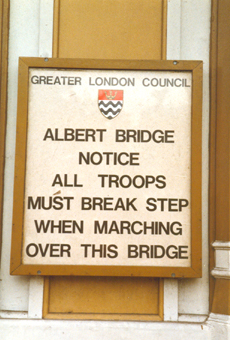Loads
A load is an example of a force. A load that does not move is called a static load. A load that moves is called a dynamic load. The animation above illustrates that a dynamic load is greater than a static load. Dynamic loads can be created by wind pressure, water pressure, vibration, shaking and collision.
Structures have to withstand the loads that they were designed to support plus the extra loads that it is possible to impose on them, e.g. a flight of stairs from one floor of a building to another should be strong enough to support a crowd of people rushing onto it in the event of an emergency.
Structures must be strong enough to support not only the static load but the dynamic load of people moving over it.
The sign opposite was photographed at the end of the Albert Bridge in London. The sign warned troops not to march in unison across the bridge as they made their way to and from Chelsea Barracks.
The dynamic loads imposed by troops marching in unison were likely to damage the bridge structure. |



